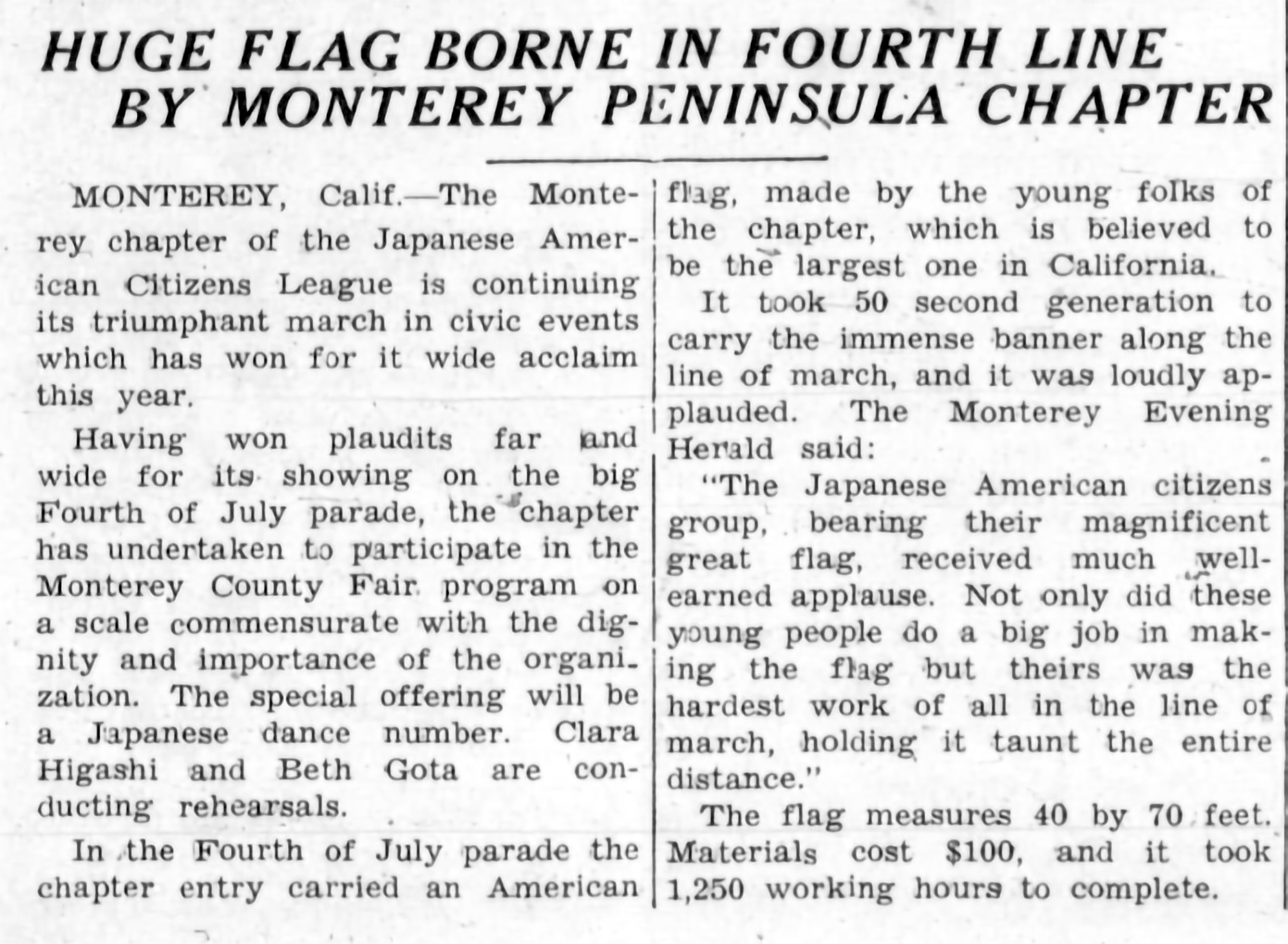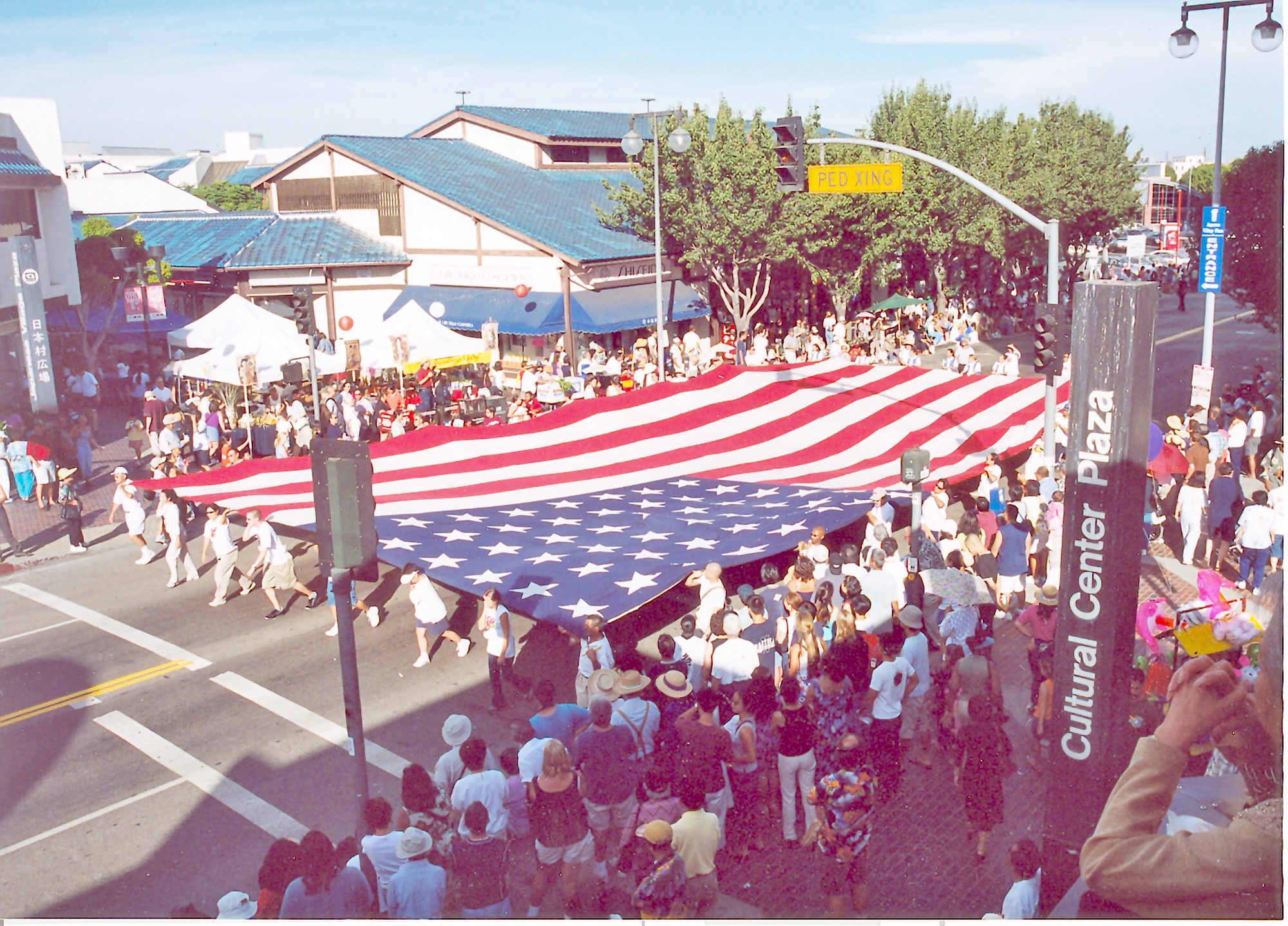The Monterey Peninsula Flag inside JANM’s main hall. Made in the 1930s, the flag is set to undergo a complete restoration. (Photo: Kristen Hayashi)
Monterey Peninsula JACL’s grand old flag
is set to have a starring role in a 2026 JANM exhibition.
By George Toshio Johnston, P.C. Senior Editor
Most Americans likely associate the word “big” with redwood trees, blue whales, elephants — maybe the state of Texas.
How about Monterey, Calif.? Huh?
Abalone? Affirmative. Cannery Row? Concurred. The Monterey Bay Aquarium? Aye aye. But when thinking “big,” the beautiful seaside-adjacent locale is not typically what comes to mind.
Think again. Why? For that, one must first revisit 1938, before the Japanese American Citizens League had reached its 10th birthday, when Japanese Americans living on the Monterey Peninsula were thinking very, very big, and the community decided to make a very, very big statement with a gargantuan American flag.
According to Larry Oda, JACL national president and stalwart member of the Monterey Peninsula JACL chapter, Monterey’s Fourth of July parade “used to be a big deal” back then. The chapter wanted to participate and show its patriotism. The idea of a float got floated but lost air when it was realized that only a limited number of people could ride one.

Japanese American National Museum CEO and President Irene Hirano, Sen. Daniel K. Inouye and Larry Oda of the Monterey Peninsula JACL pose behind the folded grand flag at a ceremony in front of the museum in Little Tokyo to mark the flag’s addition to the JANM collection in August 2001. (Photo: Courtesy of Monterey Peninsula JACL)
“Someone came up with the bright idea that, ‘Hey, ‘if we make a banner of some sort, we could all carry it,’” Oda told the Pacific Citizen. “And someone decided, ‘Well, what about an American flag?’”
But not just any run-of-the-mill, ordinary stars and bars — it needed to be big. Really big. And for a job this big, this demanding, this labor intensive, this important, the task fell to the only group of people within the Monterey JACL with the requisite skills to make it happen: the chapter’s women’s auxiliary.
There was, of course, a real-world reason the Issei and Nisei versions of Betsy Ross volunteered to do it. “They were the ones that knew how to sew,” said Oda. And “sew” it began.
◊◊◊
What the Monterey JACL brought to the 1938 Fourth of July parade was, by all accounts, a stellar success, a sight and delight to behold. At 40 feet by 70 feet, the grand new flag was believed to be the largest American flag in the state, maybe in the country (sorry, Texas). Nearly 50 women and men were needed to carry it taut along the parade route. Each stripe was the width of a bolt of red or white fabric. It took some 1,250 woman-hours to complete. The cost of the materials was $100, equivalent today to $2,280. If the labor hadn’t been voluntary, who knows how much that would have added to the cost.
One of the behind-the-scenes stars of the grand flag project was, Oda says, Grace Kodama, mother of Beverly Ito, who now serves as Keiro’s president and CEO. The family owned a dry cleaner in Monterey, and Kodama was an accomplished seamstress who also figured out how to cut the 48 five-pointed white stars needed for the blue field.
“There’s lots of legends about this, that the flag that the women of the chapter handmade it,” Oda said. It depends, of course, on how “handmade” is defined. Regardless, Kodama was savvy enough to realize that sewing the different pieces together by hand was impractical. Oda noted that Ito had told him that her mother bought an industrial sewing machine to sew the flag. “If you look at the stitching, you can tell it’s a machine stitch,” Oda said.

Pacific Citizen article from July 1938 about the then-new grand flag made by the Monterey Peninsula JACL chapter (Photo: Pacific Citizen Archive)
The Monterey JACL grand flag proved to be so popular that in the remainder of the 1930s and into the early 1940s, it was loaned out and paraded at many different venues, parades and county fairs from San Francisco to the Salinas/Monterey/Watsonville areas and, during World War II, in Utah. After the war, it was paraded through the streets of Idaho Falls, Idaho, by Nisei military veterans who had returned home.
Somewhere along the line, though, the chapter lost track of the flag. No one seemed to know what happened to it or where it went.
“We thought that we’d loaned it to somebody, and no one gave it back,” Oda recalled. But can anything that big really be lost? Evidently not because according to a letter that accompanied the flag when it was donated to the Japanese American National Museum in Los Angeles’ Little Tokyo, it was rediscovered in 1971 “in a state of disrepair” in a trunk in the chapter’s JACL Hall. The found flag made a comeback, though, appearing regularly at Monterey Fourth of July parades in the 1980s and ’90s.
So, how did the Monterey grand flag end up in Los Angeles this past April, spread across the floor of the Central Hall at JANM? The answer to that goes back a quarter century.
◊◊◊
In 2000, the JACL held its then-biennial convention in Monterey, Calif. According to Oda, this was a time when JANM would have a booth at JACL conventions — and at the JANM booth that year were Nancy Araki and Florence Ochi.
The chapter, meantime, had been discussing what to do with the flag, which was stored in a trunk in the JACL Hall’s basement. According to Oda, Araki and Ochi said, “You should give it to us. We’ll take care of it.”
“To us it was a good idea,” Oda said. “That way, it’ll be preserved.”
A plan was made to have the grand flag participate in one last Fourth of July parade in its hometown just days after the 2000 JACL convention wrapped and then transport it to Little Tokyo. “That was the last time we carried it down Alvarado Street, which is the main street in Monterey.”

The Monterey Peninsula JACL’s grand flag was last publicly displayed in Little Tokyo at the 2001 Nisei Week Parade before it was turned over to JANM, where it has been stored for nearly a quarter century. (Photo: Courtesy of Monterey Peninsula JACL)
In 2001, the Monterey Peninsula JACL’s grand flag made its Los Angeles debut as part of that year’s Nisei Week parade before going to JANM. What happened to it then? According to Dr. Kristen Hayashi, JANM’s director of Collections Management and Access, “It’s been in storage, folded in a military triangle since it came to the museum.”
◊◊◊
With the museum currently closed and with plans under way for a new core exhibition that the flag could be a part of in 2026, the time was finally right to resurrect Old Glory. With the floor of the Central Hall available to examine, clean and repair it, the grand flag was brought out of storage. Just like the flag, JANM itself is undergoing a substantial renovation.
“One of the outcomes of this renovation is to create a new core exhibition,” said Hayashi. Its title is “In the Future We Call Now: Dreams of Democracy, Realities of Racism,” and the big flag will be a big part of it.
The team at JANM literally had its hands full dealing with an artifact of this size. According to Hayashi, the flag’s condition had to be assessed, and it needed to be photographed for documentation purposes. It also needed to be vacuumed, no easy task for something this large. Tears needed to be repaired and discolorations tended to by a company that specializes in fabric restoration.
“There were these ropes that were originally attached on the underside of the flag so that they could hold onto the flag for the parades,” Hayashi told the Pacific Citizen. “Normally, we don’t remove anything that’s original from the artifact. But in this case, we felt that the ropes were doing more harm, like they were causing abrasion and to the flag, to the material.” But the location of where the ropes had been were photographed and documented if there ever was a need to someday put them back.
Another factor: Exposure to light and air can accelerate the flag’s deterioration. To be a part of next year’s exhibition, it would need a custom-made protective case; for that, the museum enlisted the services of Ralph Appelbaum Associates.
As part of “In the Future,” the flag will be in its new display case, folded into a triangle, Hayashi said, and juxtaposed with the museum’s actual concentration camp barracks, also undergoing a renovation. On one hand, there will be the flag, which represents aspirations of Japanese Americans who were “trying to show their patriotism, loyalty to this country.” On the other will be the stark barracks, representing what can happen when America strays from it ideals. “I think seeing those two artifacts together will be very poignant,” she said.
In 2026, then, and two years short of the 90th anniversary of its public debut, the Monterey Peninsula JACL chapter’s grand old flag will make its return to being in the public eye. Its journey has been both glorious and pitiable, and it has earned every blemish, abrasion and stain on it, not unlike the nation it represents.
“Just reflecting on this work that we’re doing on this enormous U.S. flag, I think has been very meaningful to me,” Hayashi said, “and it really underscores JANM’s mission, which is to promote appreciation and understanding for America’s ethnic and cultural diversity through the experience of the Japanese American story.”




